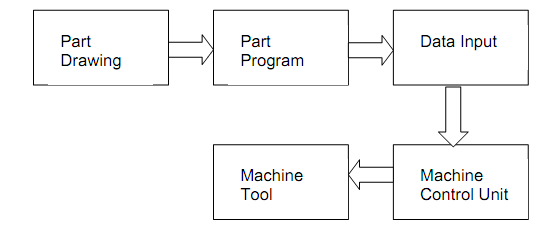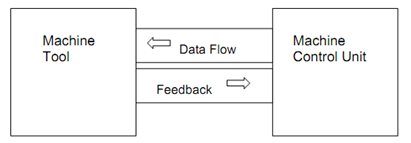Elements of Numerical Control Machines
The general structure of the operation of a typical numerical control machine tool is shown in Figure 4. The part program consists of detailed micro instructions that are written in a specific language that constitutes the basic operations to be carried out in machining of the part. These instructions are then entered into the control unit through some input medium. The controller then translates these part program instructions into the machine actuation details that are used to control the individual machine functions such as the movement of the axes or change of a particular tool.

Figure 4: Elements of NC Machine Tool Operation
The earlier system is working in an open loop control, where the actual position reached at the end of an instruction is not sensed. However, most of the NC machine tools are controlled with a feedback control system. In these systems, the feedback information is provided to the machine control unit as shown in Figure 5 to ensure that the programmed instructions are accurately carried out. The feedback provided can be positional and/or velocity.

Figure 5: The Data Processing in a CNC Machine Tool in Closed Loop Control
The NC machines developed in the early days had the total control system developed entirely using the hardware elements. As a result, the control system is actually implemented as hardware logic using a variety of SSI (Small Scale Integration) and MSI (- Medium Scale Integration, This refers to the integration of the number of transistors in an Integrated Circuit (IC). The number of transistors specifies the complexity of the circuit, and hence the capability. In comparison, microprocessors are supposed to be VLSI (Very Large Scale Integration)) integrated circuits. Typically these had very little part program memory, often only a single block. However, the availability of microprocessors has changed the controller technology drastically. The new control systems are termed as Computer Numerical Control (CNC). These are characterised by the availability of a computer as part of the controller.